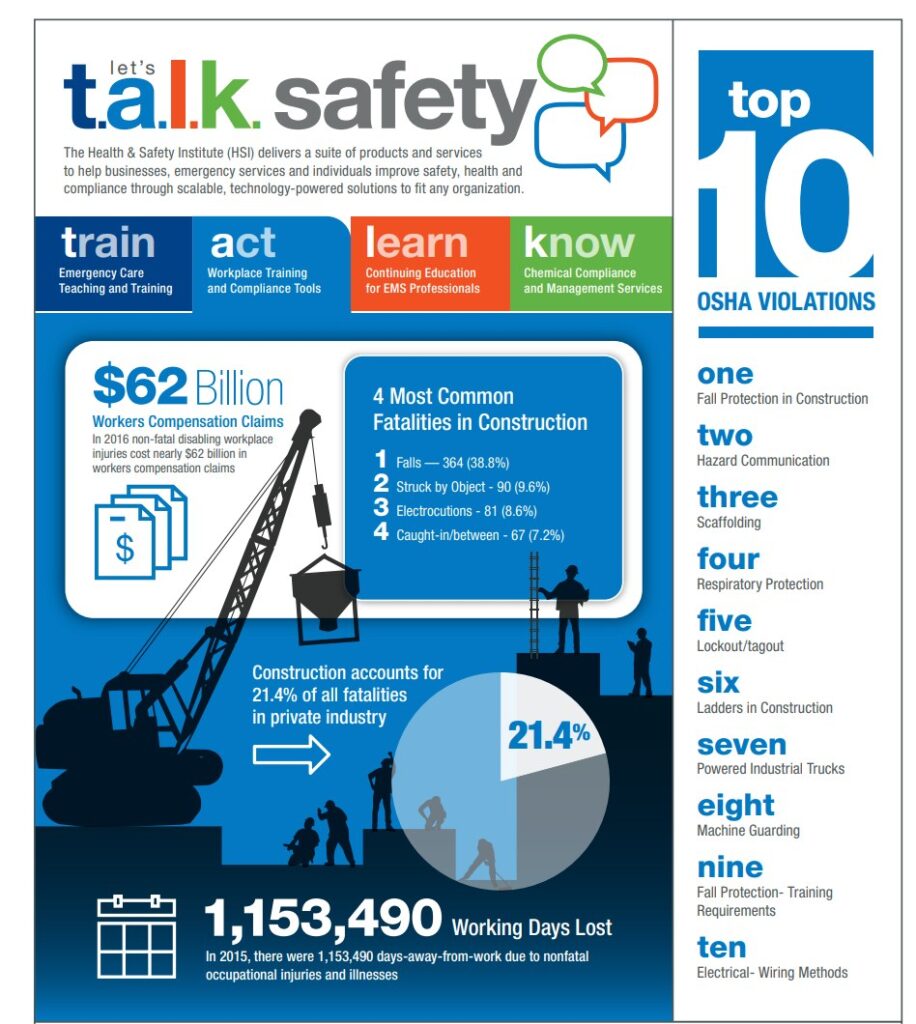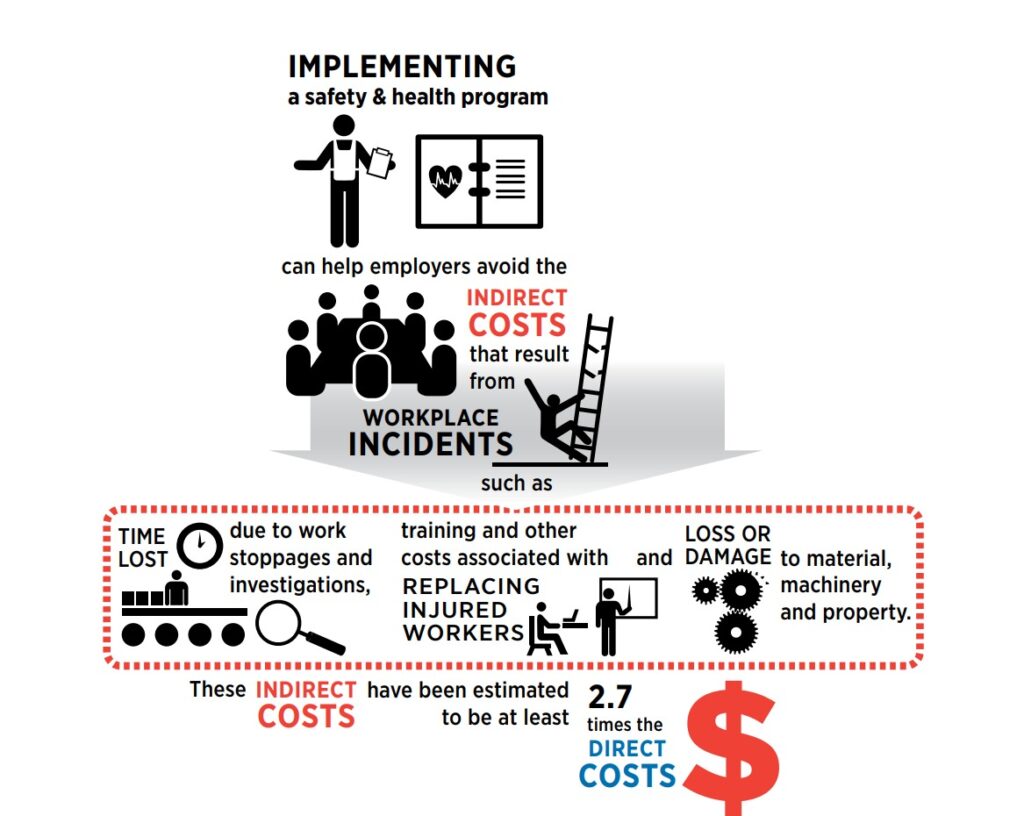Construction is an industry where hazards are commonplace and costs of workplace injuries can be devastating. Considering that construction has the second-most workplace deaths of all industries, having a construction safety plan becomes a lifeline for everyone involved in a project.
From a legal standpoint, having a detailed plan is often mandatory to comply with regulations and protect your business from liability. But even beyond legalities, a strong safety plan is a practical tool that can prevent accidents, reduce delays, and create a more productive work environment.
In this guide, we’ll walk through all you need to know about construction site safety plans, from understanding their core elements to crafting your own and ensuring it meets all necessary standards.
Steps to Creating an Effective Construction Safety Program
- Conduct a Site Assessment
- Start Developing Safety Policies and Procedures
- Train and Educate Workers
- Define Channels for Communication
- Begin Implementation
- Define the Frequency of Regular Audits
- Set Emergency Response and Preparedness Protocols
- Review and Update
What is a Construction Safety Plan?
A construction safety plan, also sometimes referred to as a Site-Specific Safety Plan (SSSP), is a comprehensive document that outlines the strategies, procedures, and measures put in place to ensure the well-being of everyone on a construction site. Its intention is to identify and address potential risks before they lead to accidents or injuries. You can include rules, roles and responsibilities, first aid protocols, exit areas, etc.
Benefits of Having a Site Safety Plan
Preventing Accidents and Injuries: A well-thought-out plan helps you identify and manage hazards, significantly reducing the risk of accidents and injuries. This can save lives, prevent worker compensation claims, and reduce project delays.
Increasing Productivity: Fewer accidents mean less downtime investigating accidents, filling out paperwork, and potentially retraining workers. A safe environment also leads to better worker morale and focus, further boosting productivity. Studies have shown that companies with strong safety cultures tend to outperform their peers in terms of productivity.
Boosting Worker Morale and Engagement: Mental health in construction has always been one of the biggest issues, and so when workers feel safe and valued, they are more likely to be engaged and motivated in their work. Engaged workers are more likely to go the extra mile, take ownership of their tasks, and contribute to the project’s success.
Protecting Your Business: They can also help shield from legal issues and financial losses. Safety violations can result in hefty fines from OSHA, and serious accidents can lead to costly lawsuits. A well-documented contractor safety plan shows that you took proactive steps to mitigate safety issues in the workplace, which can strengthen your legal defense in case of an incident.
Key Components of a Safety Plan in Construction
While the specifics may vary, a typical construction safety plan includes:
Hazard Identification: This is the foundation of any effective safety plan aiming at preventing injuries in construction. It involves a systematic process of examining your worksite, operations, materials, and equipment to pinpoint anything that could cause harm.
Risk Assessment: Once you’ve identified the hazards, it’s important to evaluate the likelihood of them occurring and the severity of the potential consequences, as not all hazards are equal. A trip hazard on a flat surface is less risky than working at heights without proper fall protection. Consider factors like the frequency of exposure to the hazard, the number of workers who could be affected, and the potential for serious injury or illness.
Control Measures: Now that you know the risks, you need a plan to address them. Of course, the goal is to eliminate hazards wherever possible. If complete elimination isn’t feasible, implement control measures to minimize the risk. Control measures can involve a hierarchy of controls, starting with engineering controls that isolate the hazard from workers. In the absence of effective engineering controls, administrative controls can be implemented, such as safe work procedures, permit systems, and restricted access zones. Finally, Personal Protective Equipment (PPE) can be used as a last line of defense.
Emergency Procedures: Even with the best plans, accidents can happen. Your safety plan should outline clear procedures for responding to various emergencies, such as medical emergencies, fires, hazardous material spills, and weather events. This section of the plan should also designate who is responsible for calling emergency services, evacuation procedures, and the location of emergency supplies and equipment.
Training and Communication: No safety plan is effective unless everyone on the site understands it. Provide comprehensive training to all workers on the specific hazards of the job site, the safety procedures they need to follow, and how to use PPE properly. Encourage open communication so workers feel comfortable reporting safety hazards, near misses, and unsafe work practices.
Recordkeeping and Documentation: Accurate records of workplace injuries, illnesses, and near-misses must be maintained. These records help identify trends, evaluate the effectiveness of safety measures, and inform future prevention efforts.

What are the OSHA Requirements for Construction Site Safety?
Workplace safety regulations, standards, and measures are enforced by the Occupational Safety and Health Administration (OSHA) to maintain optimal occupational health in the construction industry. While OSHA doesn’t mandate a specific format for safety plans, it does outline several areas that must be addressed to ensure worker well-being.
Fall Protection: OSHA’s fall protection standards are among the most important, given that falls are a leading cause of construction fatalities. Guardrails, safety nets, and personal fall arrest systems are just a few of the protective measures required when working at heights.
Hazard Communication: Clear communication about workplace hazards is mandatory. This includes providing Safety Data Sheets (SDS) for hazardous chemicals, labeling hazardous materials, and training employees on how to handle them safely.
Scaffolding: Scaffolding safety is another area of focus, with rules regarding construction, use, and construction site safety inspection to prevent collapses and accidents.
Trenching and Excavation: Trenching and excavation work can be particularly dangerous, so there are regulations on sloping, shoring, and other protective systems to prevent cave-ins.
Electrical Safety: OSHA’s electrical safety standards are designed to protect workers from electrical hazards like shocks, burns, and electrocution. These standards cover everything from grounding to lockout/tagout procedures.
Personal Protective Equipment (PPE): Employers are responsible for providing appropriate PPE like hard hats, safety glasses, gloves, and hearing protection to workers, ensuring they are used correctly.
Training: Employees must be trained on hazard recognition, the use of PPE, emergency procedures, and the specific safety regulations that apply to their work.
How to Create an Effective Construction Safety Program

Conduct a Site Assessment
Begin by thoroughly evaluating workplace safety. Note the potential hazards, considering the type of work, the environment, and the equipment being used. Look for physical hazards like unstable surfaces, slips and trip hazards, falling objects, electrical hazards, and ergonomic risks. Consider chemical hazards like dust, fumes, and lead paint. Don’t forget biological and environmental hazards such as mold, mildew, and insect bites, as well as heat safety for those sweltering hot summer months.
Start Developing Safety Policies and Procedures
Based on your assessment, create detailed safety policies and procedures. These should cover everything from the use of personal protective equipment (PPE) to the safe operation of machinery. Standard Operating Procedures (SOPs) should be established for common tasks, providing clear instructions to workers.
Train and Educate Workers
Everyone on site should understand the plan, their responsibilities, and the specific hazards they might encounter. Provide regular refresher training to reinforce safe practices.
Define Channels for Communication
Establish clear lines of communication so that workers can easily report hazards, near misses, and accidents. Encourage an open dialogue where safety concerns can be voiced without fear of reprisal.
Begin Implementation
Provide all necessary safety equipment, from hard hats and safety glasses to high-visibility vests. Also, install clear signage throughout the site to warn of potential hazards and remind workers of safety protocols.
Define the Frequency of Regular Audits
Schedule routine inspections to identify new hazards and ensure that existing control measures are working effectively. These audits should be conducted by qualified personnel and should include input from workers.
Set Emergency Response and Preparedness Protocols
Develop detailed emergency and injury response procedures for various scenarios, such as fires, falls, and medical emergencies. Ensure that all workers know the evacuation routes and the location of first-aid kits and emergency equipment.
Review and Update
Construction sites change constantly, so your plan should too. It should be regularly reviewed and updated to reflect changes in the work environment, new regulations, and lessons learned from incidents or near misses.
Conclusion
The path to a successful construction project is paved with foresight and preparation. So, don’t view a safety plan as a mere formality. See it as a strategic advantage, a tool that empowers you to build not just structures but a culture of safety.
At JobSiteCare, we understand that accidents can still happen, even with the most comprehensive safety plan. Our team of construction site medics are backed by physician-led telemedicine, ensuring your team gets the professional care they need when they need it.
To find out how JobSiteCare’s industrial medical services can complement your safety plan and provide an added layer of protection for your workforce, contact us today.
Frequently Asked Questions
What does a construction safety plan include?
A construction safety plan typically includes hazard identification and assessment, safety procedures and controls, emergency response plans, training protocols, communication channels, and procedures for regular audits and updates.
Is a contractor safety program required by OSHA?
While a formal plan may not be mandatory for all projects, OSHA requires employers to provide a safe workplace and address specific hazards with appropriate controls. A well-written plan helps demonstrate your commitment to safety and compliance.
How many sections does a safety plan have?
There’s no set number of sections, as it can vary depending on the complexity of the project.
How often should a construction safety plan be updated?
Construction safety plans should be reviewed and updated regularly, especially when there are changes in site conditions, work activities, or regulations. Regular audits can also identify areas for improvement and ensure the plan remains current and effective.
Who is responsible for the safety plan on a construction site?
Ultimately, everyone shares responsibility for safety. However, the project manager or a designated safety officer typically oversees the development and implementation of the plan.


